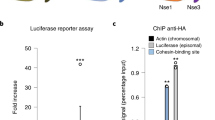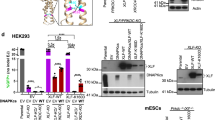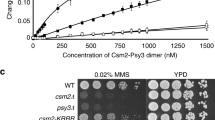Abstract
In mammalian cells, a conserved multiprotein complex of Mre11, Rad50 and NBS1 (also known as nibrin and p95) is important for double-strand break repair, meiotic recombination and telomere maintenance1,2,3,4. This complex forms nuclear foci and may be a sensor of double-strand breaks. In the absence of the early region E4, the double-stranded DNA genome of adenovirus is joined into concatemers too large to be packaged5,6. We have investigated the cellular proteins involved in this concatemer formation and how they are inactivated by E4 products during a wild-type infection. Here we show that concatemerization requires functional Mre11 and NBS1, and that these proteins are found at foci adjacent to viral replication centres. Infection with wild-type virus results in both reorganization and degradation of members of the Mre11–Rad50–NBS1 complex. These activities are mediated by three viral oncoproteins that prevent concatemerization. This targeting of cellular proteins involved in genomic stability suggests a mechanism for ‘hit-and-run’ transformation observed for these viral oncoproteins7.
This is a preview of subscription content, access via your institution
Access options
Subscribe to this journal
Receive 51 print issues and online access
$199.00 per year
only $3.90 per issue
Buy this article
- Purchase on Springer Link
- Instant access to full article PDF
Prices may be subject to local taxes which are calculated during checkout





Similar content being viewed by others
References
Haber, J. E. The many interfaces of Mre11. Cell 95, 583–586 (1998)
Petrini, J. H. The mammalian Mre11–Rad50–nbs1 protein complex: integration of functions in the cellular DNA-damage response. Am. J. Hum. Genet. 64, 1264–1269 (1999)
Zhu, X. D., Kuster, B., Mann, M., Petrini, J. H. & Lange, T. Cell-cycle-regulated association of RAD50/MRE11/NBS1 with TRF2 and human telomeres. Nature Genet. 25, 347–352 (2000)
Carney, J. P. et al. The hMre11/hRad50 protein complex and Nijmegen breakage syndrome: linkage of double-strand break repair to the cellular DNA damage response. Cell 93, 477–486 (1998)
Weiden, M. D. & Ginsberg, H. S. Deletion of the E4 region of the genome produces adenovirus DNA concatemers. Proc. Natl Acad. Sci. USA 91, 153–157 (1994)
Boyer, J., Rohleder, K. & Ketner, G. Adenovirus E4 34k and E4 11k inhibit double strand break repair and are physically associated with the cellular DNA-dependent protein kinase. Virology 263, 307–312 (1999)
Nevels, M., Tauber, B., Spruss, T., Wolf, H. & Dobner, T. “Hit-and-run” transformation by adenovirus oncogenes. J. Virol. 75, 3089–3094 (2001)
Bridge, E. & Ketner, G. Redundant control of adenovirus late gene expression by early region 4. J. Virol. 63, 631–638 (1989)
Halbert, D. N., Cutt, J. R. & Shenk, T. Adenoviral early region 4 encodes functions required for efficient DNA replication, late expression, and host cell shutoff. J. Virol. 56, 250–257 (1985)
Weinberg, D. H. & Ketner, G. Adenoviral early region 4 is required for efficient viral DNA replication and for late gene expression. J. Virol. 57, 833–838 (1986)
Bridge, E. & Ketner, G. Interaction of adenoviral E4 and E1b products in late gene expression. Virology 174 (1990)
Riballo, E. et al. Identification of a defect in DNA ligase IV in a radiosensitive leukaemia patient. Curr. Biol. 9, 699–702 (1999)
Lombard, D. B. & Guarente, L. Nijmegen breakage syndrome disease protein and MRE11 at PML nuclear bodies and meiotic telomeres. Cancer Res. 60, 2331–2334 (2000)
Maser, R. S. et al. Mre11 complex and DNA replication: linkage to E2F and sites of DNA synthesis. Mol. Cell. Biol. 21, 6006–6016 (2001)
Wu, G., Lee, W. H. & Chen, P. L. NBS1 and TRF1 colocalize at promyelocytic leukemia bodies during late S/G2 phases in immortalized telomerase-negative cells. J. Biol. Chem. 275, 30618–30622 (2000)
Nelms, B. E., Maser, R. S., MacKay, J. F., Lagally, M. G. & Petrini, J. H. In situ visualization of DNA double-strand break repair in human fibroblasts. Science 280, 590–592 (1998)
Zhao, S. et al. Functional link between ataxia-telangiectasia and Nijmegen breakage syndrome gene products. Nature 405, 473–477 (2000)
Gatei, M. et al. ATM-dependent phosphorylation of nibrin in response to radiation exposure. Nature Genet. 25, 115–119 (2000)
Wu, X. et al. ATM phosphorylation of Nijmegen breakage syndrome protein is required in a DNA damage response. Nature 405, 477–482 (2000)
Cathomen, T. & Weitzman, M. D. A functional complex of adenovirus proteins E1B-55 kDa and E4orf6 is necessary to modulate the expression level of p53 but not its transcriptional activity. J. Virol. 74, 11407–11412 (2000)
Querido, E. et al. Degradation of p53 by adenovirus E4orf6 and E1B55K proteins occurs via a novel mechanism involving a Cullin-containing complex. Genes Dev. 15, 3104–3117 (2001)
Doucas, V. et al. Adenovirus replication is coupled with the dynamic properties of the PML nuclear structure. Genes Dev. 10, 196–207 (1996)
de Vries, E., van Driel, W., Bergsma, W. G., Arnberg, A. C. & van der Vliet, P. C. HeLa nuclear protein recognizing DNA termini and translocating on DNA forming a regular DNA-multimeric protein complex. J. Mol. Biol. 208, 65–78 (1989)
Moreau, S., Ferguson, J. R. & Symington, L. S. The nuclease activity of Mre11 is required for meiosis but not for mating type switching, end joining, or telomere maintenance. Mol. Cell. Biol. 19, 556–566 (1999)
Haber, J. E. A super new twist on the initiation of meiotic recombination. Cell 89, 163–166 (1997)
Bressan, D. A., Olivares, H. A., Nelms, B. E. & Petrini, J. H. Alteration of N-terminal phosphoesterase signature motifs inactivates Saccharomyces cerevisiae Mre11. Genetics 150, 591–600 (1998)
Naviaux, R. K., Costanzi, E., Haas, M. & Verma, I. M. The pCL vector system: rapid production of helper-free, high-titer, recombinant retroviruses. J. Virol. 70, 5701–5705 (1996)
Weinberg, D. H. & Ketner, G. A cell line that supports the growth of a defective early region 4 deletion mutant of human adenovirus type 2. Proc. Natl Acad. Sci. USA 80, 5383–5386 (1983)
Weitzman, M. D., Fisher, K. J. & Wilson, J. M. Recruitment of wild-type and recombinant adeno-associated virus into adenovirus replication centers. J. Virol. 70, 1845–1854 (1996)
Acknowledgements
We thank G. Ketner for the E4 mutant viruses and W162 cells, I. Verma for retrovirus constructs and cell lines, T. Paull for cDNAs; B. Gilbert for technical assistance; S. Malpel for complemented NBS cells; J. Bailis for advice on PFGE; M. Blower and the Center for Cytometry and Molecular Imaging at the Salk Institute for deconvolution assistance; J. Simon for help with figures; J. Weitzman, M. Grifman, T. Cathomen, C. Barlow, R. Bushman and S. Forsburg for critically reading the manuscript; R. Evans, T. Hunter, G. Wahl, B. Sefton, D. Spector, T. de Lange and J. Petrini for discussions; S. Stampfer for encouragement; and the James B. Pendleton Charitable Trust for providing the Pendelton Microscopy Facility. M.D.W. is supported in part by a grant from NIH, and by gifts from the Joe W. & Dorothy Dorsett Brown Foundation and the Lebensfeld Foundation. T.S. was supported by an NIH Graduate Training Grant to UCSD, and by fellowships from the Chapman Foundation, the Legler Benbough Foundation and the Salk Institute Association.
Author information
Authors and Affiliations
Corresponding author
Ethics declarations
Competing interests
The authors declare that they have no competing financial interests.
Rights and permissions
About this article
Cite this article
Stracker, T., Carson, C. & Weitzman, M. Adenovirus oncoproteins inactivate the Mre11–Rad50–NBS1 DNA repair complex. Nature 418, 348–352 (2002). https://doi.org/10.1038/nature00863
Received:
Accepted:
Issue Date:
DOI: https://doi.org/10.1038/nature00863
This article is cited by
-
The immediate-early protein 1 of human herpesvirus 6B interacts with NBS1 and inhibits ATM signaling
EMBO Reports (2024)
-
The interactions between PML nuclear bodies and small and medium size DNA viruses
Virology Journal (2023)
-
Cisplatin-induced cell death increases the degradation of the MRE11-RAD50-NBS1 complex through the autophagy/lysosomal pathway
Cell Death & Differentiation (2023)
-
Antiviral immunity and nucleic acid sensing in haematopoietic stem cell gene engineering
Gene Therapy (2021)
-
Adenovirus-mediated ubiquitination alters protein–RNA binding and aids viral RNA processing
Nature Microbiology (2020)
Comments
By submitting a comment you agree to abide by our Terms and Community Guidelines. If you find something abusive or that does not comply with our terms or guidelines please flag it as inappropriate.



